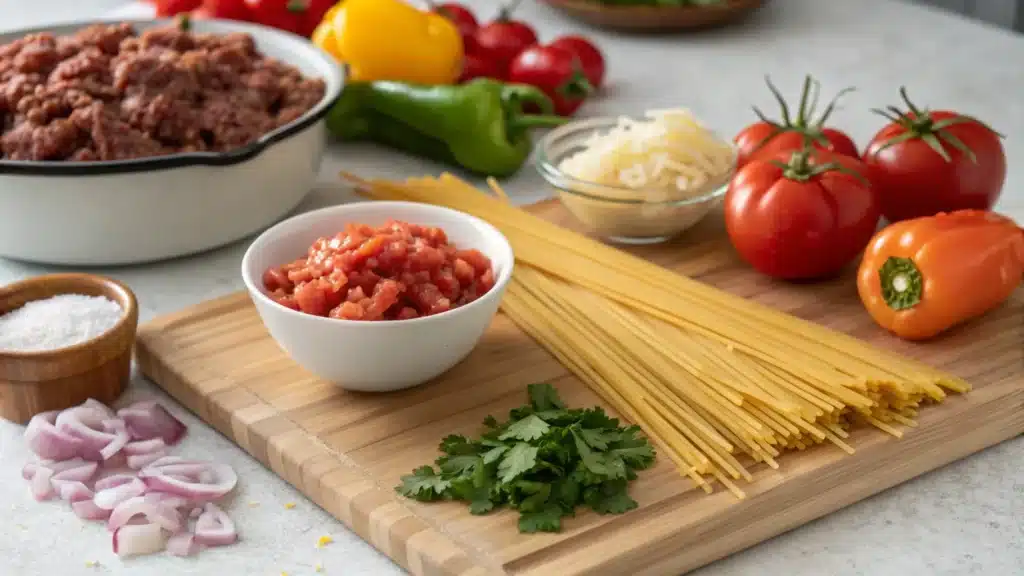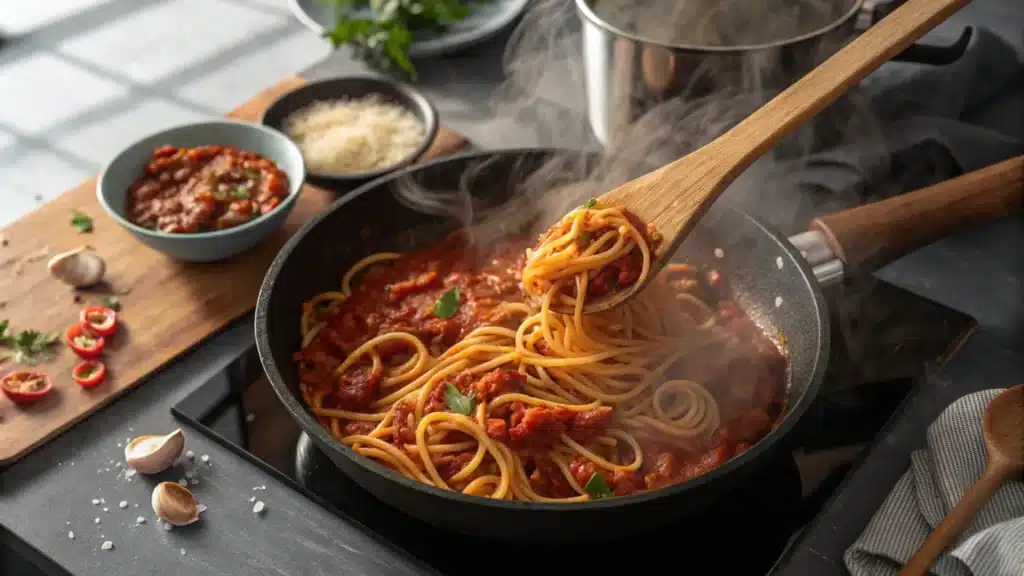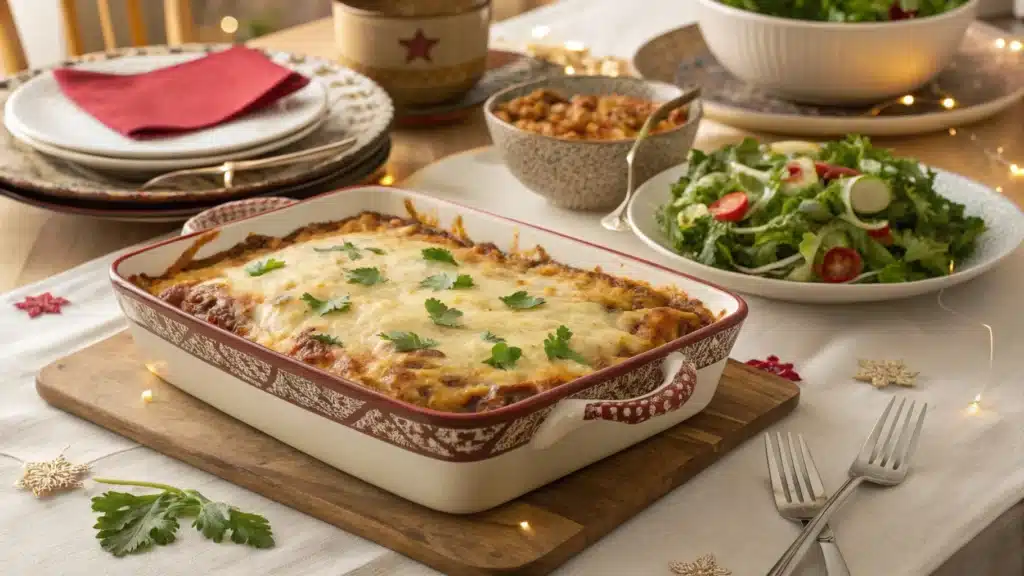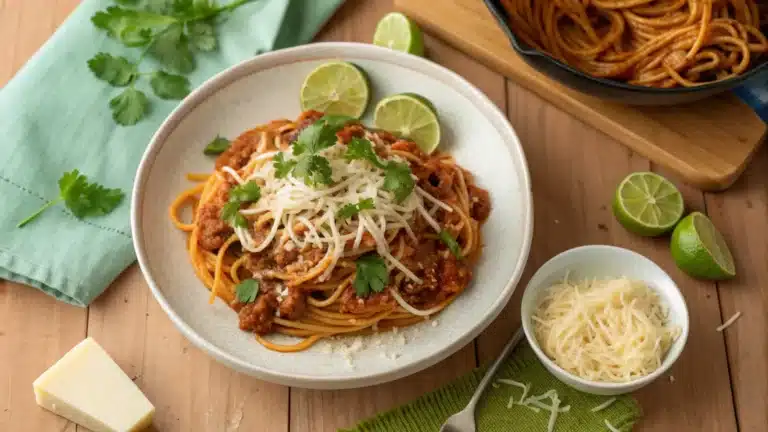Mexican spaghetti is a flavorful twist on the classic pasta dish, blending the vibrant tastes of Mexican cuisine with the comfort of spaghetti. This dish is rich, hearty, and brimming with spices, offering a perfect balance of savory and slightly tangy flavors. Throughout this article, you’ll discover the ingredients that make Mexican spaghetti unique, its step by step preparation, and the cultural significance behind this delightful fusion.
Table of contents
Introduction to Mexican Spaghetti
What is Mexican Spaghetti?
At its core, Mexican spaghetti is a dish that merges the traditional elements of Italian spaghetti with the bold, robust flavors of Mexican cooking. Instead of relying solely on marinara sauce and herbs, this dish incorporates ingredients like chili powder, cumin, and even jalapeños to give it a zesty kick. It’s a fusion that speaks to the creativity and adaptability of Mexican-American cuisine, where familiar staples are reinvented to suit local tastes.
The pasta is typically paired with a rich, spiced tomato based sauce and protein, such as ground beef or chicken. What truly sets it apart are the garnishes fresh cilantro, queso fresco, or even a squeeze of lime—that Promote its flavor profile.
How it Differs from Traditional Italian Spaghetti
Unlike its Italian counterpart, Mexican spaghetti leans heavily on bold seasonings and fiery flavors. Instead of olive oil and basil, you’ll find spices like paprika and garlic powder taking center stage. Mexican spaghetti often incorporates additional layers of texture and flavor, such as sautéed onions, bell peppers, and a dash of hot sauce.
Additionally, the pasta is cooked just until tender, allowing it to soak up the rich, spicy sauce. This creates a dish that’s as much about the sauce and toppings as it is about the pasta itself—a hallmark of Mexican comfort food.
Core Ingredients of Mexican Spaghetti
What is Mexican Spaghetti Made Of?
Mexican spaghetti is a delicious fusion of pasta and the bold, vibrant flavors of Mexican cuisine. It combines tender spaghetti with a rich, spiced tomato based sauce, creating a dish that’s hearty, satisfying, and packed with flavor. Here’s what typically goes into it:
Ingredients:
• 1 lb – spaghetti pasta
• 1 lb – ground beef or ground pork
• 1 can (14 oz) – crushed tomatoes
• 1 small can – tomato paste
• 1 cup – chicken broth
• 1/2 cup – diced onion
• 1/2 cup – diced bell peppers
• 2 cloves – minced garlic
• 1 tsp – chili powder
• 1 tsp – cumin
• 1/2 tsp – smoked paprika
• 1/2 tsp – garlic powder
• 1/2 tsp – onion powder
• 1/4 tsp – cayenne pepper (optional)
• 1/2 cup – shredded cheese (Monterey Jack or queso fresco)
• 2 tbsp – chopped cilantro (garnish)

The core ingredients combine to deliver a dish that’s bursting with flavor. Spices like chili powder, cumin, and garlic powder create depth, while fresh vegetables like onions and bell peppers add a vibrant taste. Optional touches, such as jalapeños for heat or lime juice for brightness, can make the dish even more exciting.
How to Make Mexican Spaghetti
Step-by-Step Recipe Overview
Preparing Mexican spaghetti is as straightforward as it is rewarding. Here’s a step-by-step guide to bringing this comforting dish to your table:
Instructions:
- Start by boiling the spaghetti in salted water until al dente. Drain and set aside.
- In a large skillet, heat some oil over medium heat. Add diced onions, bell peppers, and minced garlic, sautéing them until softened and fragrant.
- Add ground beef or ground pork to the skillet, breaking it apart as it cooks. Cook until browned, then drain any excess fat if needed.
- Stir in the crushed tomatoes, tomato paste, and chicken broth to create a rich sauce. Add the chili powder, cumin, smoked paprika, garlic powder, onion powder, and cayenne pepper if desired. Let the sauce simmer for 10 minutes, allowing the flavors to meld.
- Toss the cooked spaghetti into the skillet, mixing thoroughly to Secure every strand is coated with sauce.
- Serve the spaghetti topped with shredded cheese and a sprinkle of cilantro. For an extra burst of flavor, add a squeeze of lime juice.

Tips for Success
- Always cook the spaghetti al dente to prevent it from becoming mushy when mixed with the sauce.
- Adjust the spice level to your liking by adding more chili powder or jalapeños for heat, or omitting them for a milder dish.
- If the sauce is too thick, add a splash of reserved pasta water to loosen it up.
This dish combines the best of both worlds: the comfort of pasta and the bold flavors of Mexican cuisine, making it a standout meal for any occasion.
Variations and Customizations
Vegetarian and Vegan Alternatives
Mexican spaghetti is a versatile dish that adapts beautifully to dietary preferences. For a vegetarian version, replace the ground beef with plant based protein like lentils, black beans, or a meat substitute. Vegan options are just as easy—swap out the shredded cheese for vegan cheese, and Secure the sauce ingredients are free from animal products.
Adding vegetables like zucchini, mushrooms, or spinach Improves the dish’s texture and flavor. You can also experiment with plant-based sour cream or avocado slices for creamy garnishes. These tweaks make the dish lighter while still retaining its signature Mexican flavor.
Regional Twists on Mexican Spaghetti
Every region has its unique take on Mexican spaghetti. Some recipes incorporate poblano peppers for a smokier taste, while others use chipotle in adobo for a tangy, spicy kick. In Tex-Mex-inspired versions, adding layers of cheese and baking the dish casserole-style is a popular twist.
These regional variations reflect the adaptability of Mexican spaghetti, offering endless ways to enjoy this crowd pleasing dish. Want to try something similar? Check out our guide to green spaghetti, another Tex-Mex favorite packed with bold flavors.
The Cultural Significance of Mexican Spaghetti
Why Mexican Spaghetti Became a Household Favorite
Mexican spaghetti has carved a place in many households due to its fusion of familiar pasta and bold Mexican spices. This dish resonates with families who seek comforting yet flavorful meals that are easy to prepare. Its ability to be customized makes it perfect for picky eaters and adventurous foodies alike.
In Mexican-American communities, this dish is a staple at gatherings and weeknight dinners. It’s a reminder of home, blending tradition with modern convenience. With its rich sauce, tender pasta, and customizable toppings, it bridges cultures in the most delicious way.
Modern Takes on a Traditional Dish
Contemporary chefs and home cooks have embraced Mexican spaghetti, adding their creative spins. From gluten free pasta options to gourmet cheese toppings, the dish continues to evolve while staying true to its roots. Its growing popularity highlights its appeal as both a nostalgic comfort food and a creative culinary canvas.
For more delicious recipes with bold flavors, check out our recipe for Mexican lasagna.
Nutritional Value and Health Tips
Is Mexican Spaghetti a Healthy Meal?
Mexican spaghetti can be a healthy meal, especially when prepared with the right ingredients. For example, its main components pasta, meat, vegetables, and spices—provide a mix of energy, protein, and important nutrients. Additionally, fresh vegetables like tomatoes, bell peppers, and onions add a good dose of vitamins and antioxidants, which help keep your body strong.
However, it’s worth noting that some versions of Mexican spaghetti may be high in calories and salt, especially if made with fatty meats, lots of cheese, or store-bought sauces. To make it better for you, try using lean meats like turkey or chicken. Similarly, opting for whole-grain pasta can add more fiber and make the dish more filling.
Easy Ways to Make It Better for You
If you’re wondering “What is Mexican spaghetti made of?” and how to make it healthier, the answer lies in making small, smart swaps. For instance, you can use whole grain or gluten free pasta to boost fiber. Additionally, using low sodium canned tomatoes and fresh herbs helps reduce salt levels. To cut down on fat, you could use less cheese or switch to plant based cheese.
Moreover, adding extra vegetables like zucchini, spinach, or mushrooms makes the dish both more nutritious and filling. With these simple changes, you can enjoy a meal that’s delicious, balanced, and guilt-free.
Fun Ways to Serve Mexican Spaghetti
How to Serve It in Creative Ways
Mexican spaghetti is not just delicious—it’s also easy to serve in fun and creative ways! For instance, you could serve it directly from the skillet for a warm and inviting family dinner. On the other hand, if you’re hosting a party, try serving individual portions in small bowls garnished with fresh cilantro and lime wedges. This not only looks great but also adds extra flavor to the dish.
Another idea is to bake the spaghetti in a casserole dish with cheese on top. As the cheese melts and becomes golden, it creates a crispy and flavorful crust. Because of this, the dish becomes even more appealing to kids and adults alike.

Best Side Dishes to Pair With It
When it comes to pairing Mexican spaghetti with sides, there are many great options to choose from. For example, a fresh green salad with a light citrus dressing balances out the rich flavors of the spaghetti. Additionally, for a more authentic Mexican touch, you can serve it with warm tortillas or street corn (elote).
As for drinks, consider serving fresh fruit water (agua fresca) or a refreshing soda. Together, these elements create a full, satisfying meal that everyone will enjoy.
FAQs
What Ingredient is Spaghetti Made Of?
Spaghetti, as the foundation of this dish, uses a blend of durum wheat semolina and water. This simple recipe creates its firm texture, which works perfectly for holding sauces. Moreover, when you pair it with bold flavors like those in Mexican spaghetti, the dish transforms into something extraordinary and flavorful.
Does Mexico Have a Pasta Dish?
Yes, Mexican cuisine includes several unique pasta dishes. For example, traditional recipes like fideo feature short noodles cooked in tomato broth, while sopa seca offers a “dry soup” made with pasta. Similarly, Mexican spaghetti adds another creative twist, blending familiar pasta with Mexican spices. These dishes showcase how Mexican chefs embrace and Redesign pasta in exciting ways.
What is Del Monte Spaghetti Made Of?
Del Monte crafts its spaghetti using enriched durum wheat flour, while its ready made sauces include tomatoes, garlic, and herbs. However, you can Promote a basic Del Monte spaghetti recipe by incorporating cumin, chili powder, or smoked paprika. These ingredients infuse the dish with the bold, authentic taste that Mexican spaghetti is known for.
What is Traditional Spaghetti Sauce Made Of?
Traditional spaghetti sauce typically includes tomatoes, garlic, onions, olive oil, and herbs such as basil or oregano. However, Mexican spaghetti takes it a step further by adding chili powder, paprika, or even chipotle. These additional spices create a rich and slightly spicy sauce, which perfectly complements the hearty pasta.
Conclusion and Final Thoughts
Mexican spaghetti offers a delightful combination of comfort and boldness. By merging traditional pasta with Mexican-inspired ingredients, this dish answers the question, “What is Mexican spaghetti made of?”, with creativity and flavor.
In addition to its robust flavors, the recipe’s adaptability makes it a favorite in many households. For example, you can replace ground beef with plant based proteins or add vegetables like zucchini for extra texture. Furthermore, adjusting the level of spice allows you to cater to everyone’s taste. These small changes help you create a dish that feels fresh and exciting every time.
Culturally, Mexican spaghetti highlights the beauty of fusion cuisine. While it brings together Italian and Mexican traditions, it also represents the ingenuity of home cooks who enjoy blending familiar flavors. As a result, this dish has become a go-to recipe for both family dinners and special occasions.
Finally, if you love exploring more Mexican-inspired pasta dishes, don’t miss our guide to green spaghetti. Additionally, you can try the layered goodness of our Mexican lasagna recipe. Together, these recipes showcase the versatility and creativity of Mexican fusion cuisine.

